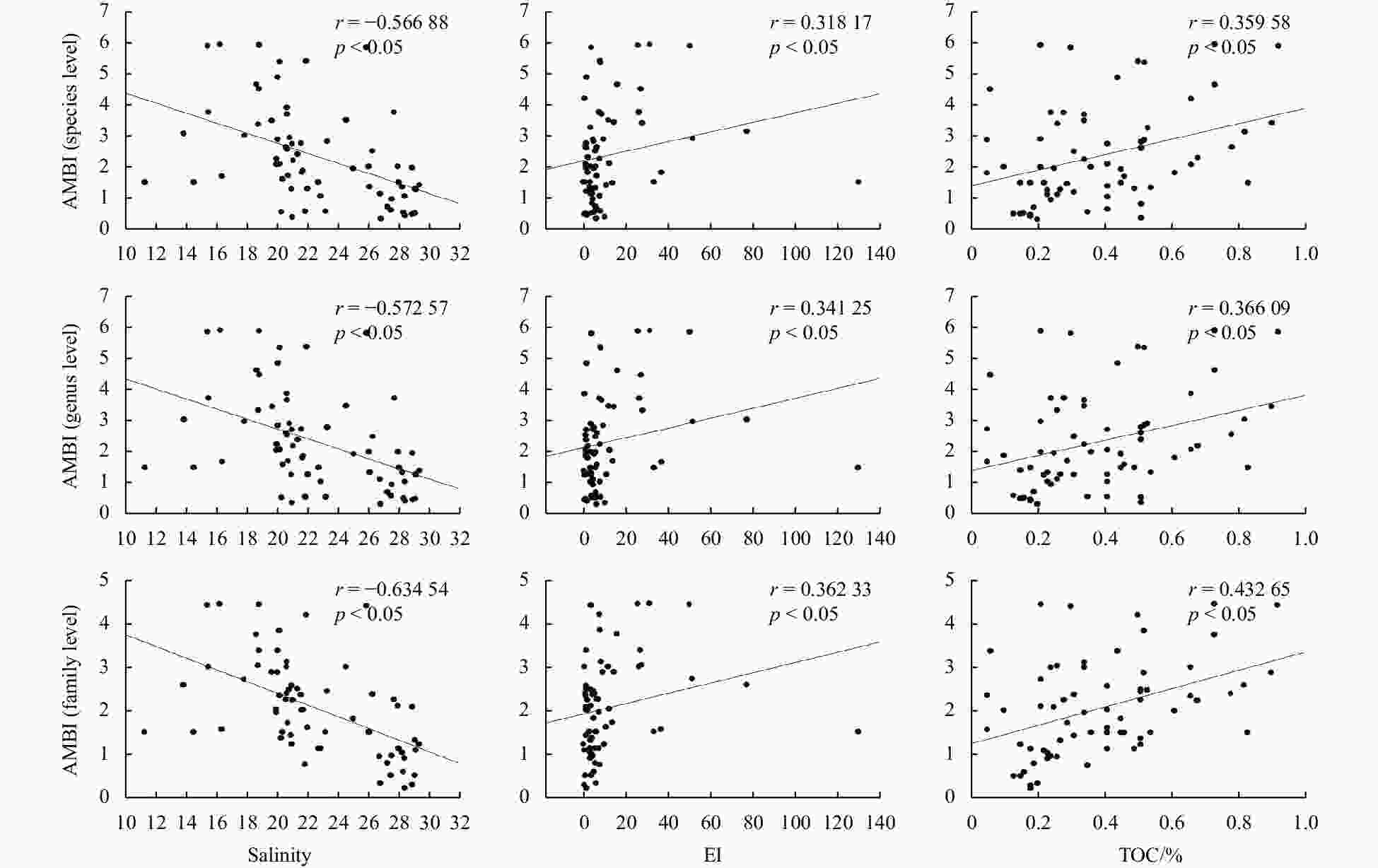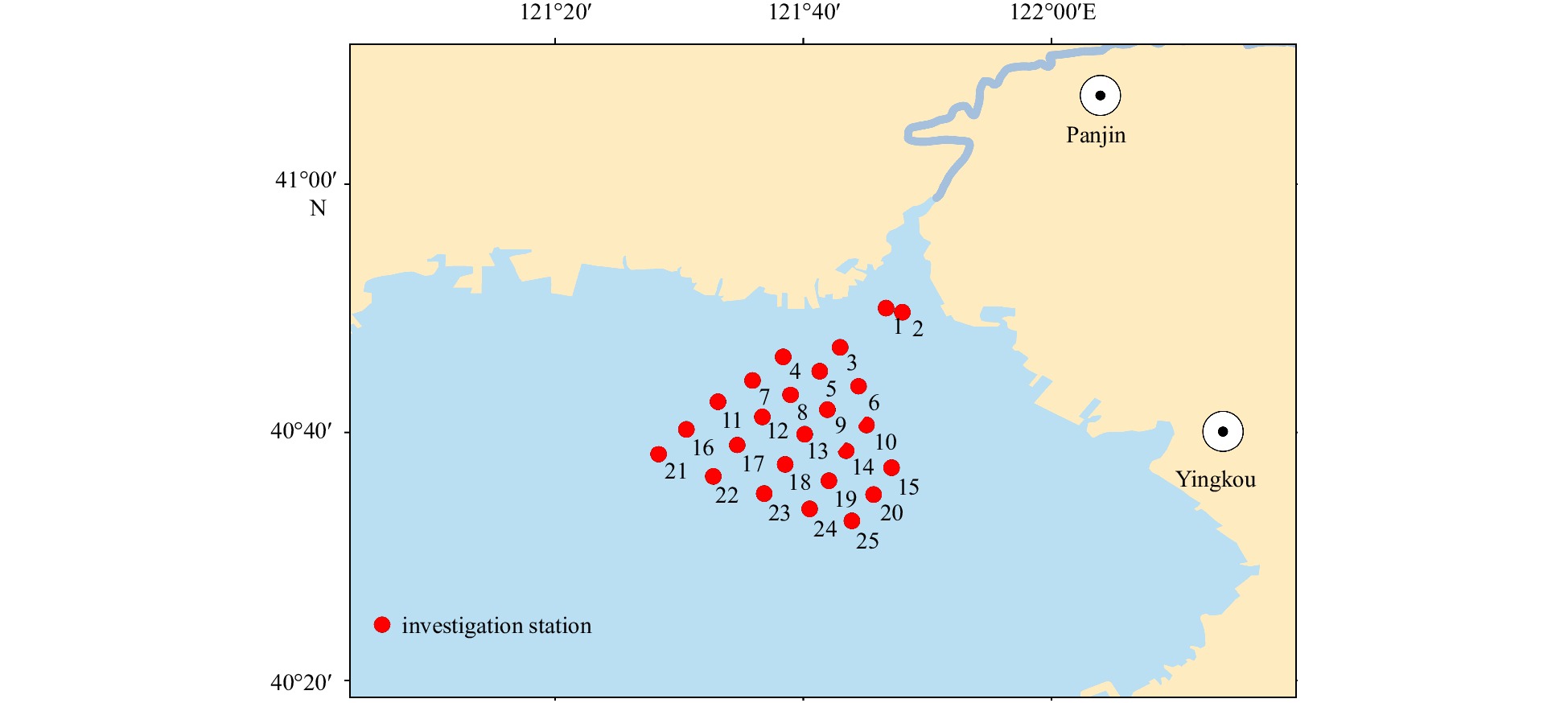Seasonal implications for taxonomic sufficiency to simplify M-AMBI methodology in the coastal area adjacent to a eutrophic estuary
-
Abstract: Taxonomic sufficiency (TS) refers to identifying taxa to a taxonomic level sufficient to detect community changes in stressed environments and may provide a cost-effective approach in routine monitoring programs. However, there is still limited information regarding the seasonal impact of applying TS and its implications for the ecological quality evaluation in the estuarine ecosystem. This study investigated the relationship between the multivariate-AZTI’s Marine Biotic Index (M-AMBI) and environmental variables in three seasons (i.e., spring, summer, and autumn) in the Liaohe River Estuary. We tested the reliability of TS for simplifying the M-AMBI methodology. The results showed that family and genus level data could reproduce the spatial-temporal patterns of community structure at the species level. The M-AMBI values showed a consistent spatial distribution pattern in all sampling seasons, with a decreasing trend with the increasing distance from the estuary mouth. Both genus and family level data performed nearly as well as species level in detecting the seasonal variations of pollutants (i.e., nutrients and total organic content). The family level M-AMBI was feasible to discern stress in the Liaohe River Estuary because of the high aggregation ratios at different taxonomic levels in all sampling seasons. These findings suggest that applying taxonomic sufficiency based on the M-AMBI provides an efficient approach for evaluating ecological quality in the Liaohe River Estuary.
-
Key words:
- M-AMBI /
- ecological quality /
- macrofauna /
- taxonomic sufficiency /
- eutrophication /
- Liaohe River Estuary
-
Figure 2. Spatial-temporal distribution of environmental variables (Chl-a: Chlorophyll a concentration; COD: chemical oxygen demand concentration; TOC: total organic carbon content; PHc: petroleum hydrocarbons content) in the Liaohe River Estuary. The stations were divided into six categories based on the distance from the station to the river inlet (A: Nos S1–S2; B: Nos S3–S6; C: Nos S7–S10; D: Nos S11–S15; E: Nos S16–S20; F: Nos S21–S25).
Table 1. Summary of family, genus, species counts, aggregation ratio (
$\phi $ ) for higher taxonomic resolutions, and dominant species in three seasons. Ecological groups assigned to dominant species are presented in the parenthesisSeason Family ($\phi $) Genus ($\phi $) Species Dominant species (Ecological Group) Spring 45 (0.80) 48 (0.86) 56 Potamocorbula ustulata (V) Ampelisca sp. (I) Summer 47 (0.80) 58 (0.98) 59 Potamocorbula laevis (V) Capitella capitata (V) Autumn 45 (0.85) 47 (0.89) 53 Corophium acherusicum (III) Grandidierella sp. (I) Amphioplus sp. (I) Capitella capitata (V) Potamocorbula laevis (V) Glossaulax didyma (I) Table 2. Number of stations for each ecological quality (EcoQ) classification using the M-AMBI calculated with aggregated datasets
EcoQ
classificationAggregation level Species Genus Family High 7 7 9 Good 31 30 29 Moderate 10 10 12 Poor 13 14 12 Bad 5 5 4 Total 66 66 66 Note: Standard EcoQ classification boundaries used; for status, High, $\geqslant $0.77; Good, [0.53, 0.77); Moderate, [0.39, 0.53); Poor, [0.20, 0.39); Bad, <0.20. -
Bertasi F, Colangelo M A, Colosio F, et al. 2009. Comparing efficacy of different taxonomic resolutions and surrogates in detecting changes in soft bottom assemblages due to coastal defence structures. Marine Pollution Bulletin, 58(5): 686–694. doi: 10.1016/j.marpolbul.2009.01.003 Bevilacqua S, Mistri M, Terlizzi A, et al. 2018. Assessing the effectiveness of surrogates for species over time: Evidence from decadal monitoring of a Mediterranean transitional water ecosystem. Marine Pollution Bulletin, 131: 507–514. doi: 10.1016/j.marpolbul.2018.04.047 Bevilacqua S, Terlizzi A, Claudet J, et al. 2012. Taxonomic relatedness does not matter for species surrogacy in the assessment of community responses to environmental drivers. Journal of Applied Ecology, 49(2): 357–366. doi: 10.1111/j.1365-2664.2011.02096.x Borja A, Bricker S B, Dauer D M, et al. 2008. Overview of integrative tools and methods in assessing ecological integrity in estuarine and coastal systems worldwide. Marine Pollution Bulletin, 56(9): 1519–1537. doi: 10.1016/j.marpolbul.2008.07.005 Borja Á, Elliott M. 2013. Marine monitoring during an economic crisis: the cure is worse than the disease. Marine Pollution Bulletin, 68(1–2): 1–3. doi: 10.1016/j.marpolbul.2013.01.041 Borja A, Elliott M, Andersen J H, et al. 2016. Overview of integrative assessment of marine systems: the ecosystem approach in practice. Frontiers in Marine Science, 3: 20. doi: 10.3389/fmars.2016.00020 Borja A, Franco J, Pérez V. 2000. A marine biotic index to establish the ecological quality of soft-bottom benthos within European estuarine and coastal environments. Marine Pollution Bulletin, 40(12): 1100–1114. doi: 10.1016/S0025-326X(00)00061-8 Borja A, Josefson A B, Miles A, et al. 2007. An approach to the intercalibration of benthic ecological status assessment in the North Atlantic ecoregion, according to the European Water Framework Directive. Marine Pollution Bulletin, 55(1–6): 42–52. doi: 10.1016/j.marpolbul.2006.08.018 Borja A, Miles A, Occhipinti-Ambrogi A, et al. 2009. Current status of macroinvertebrate methods used for assessing the quality of European marine waters: implementing the Water Framework Directive. Hydrobiologia, 633(1): 181–196. doi: 10.1007/s10750-009-9881-y Chainho P, Lane M F, Chaves M L, et al. 2007b. Taxonomic sufficiency as a useful tool for typology in a poikilohaline estuary. Hydrobiologia, 587(1): 63–78. doi: 10.1007/s10750-007-0694-6 Checon H H, Corte G N, Muniz P, et al. 2018. Unraveling the performance of the benthic index AMBI in a subtropical bay: The effects of data transformations and exclusion of low-reliability sites. Marine Pollution Bulletin, 126: 438–448. doi: 10.1016/j.marpolbul.2017.11.059 Cohen J. 1960. A coefficient of agreement for nominal scales. Educational and Psychological Measurement, 20(1): 37–46. doi: 10.1177/001316446002000104 Costanza R, d’Arge R, De Groot R, et al. 1997. The value of the world’s ecosystem services and natural capital. Nature, 387(6630): 253–260. doi: 10.1038/387253a0 De-La-Ossa-Carretero J A, Simboura N, Del-Pilar-Ruso Y, et al. 2012. A methodology for applying taxonomic sufficiency and benthic biotic indices in two Mediterranean areas. Ecological Indicators, 23: 232–241. doi: 10.1016/j.ecolind.2012.03.029 Dias H Q, Sukumaran S, Srinivas T, et al. 2018. Ecological quality status evaluation of a monsoonal tropical estuary using benthic indices: comparison via a seasonal approach. Environmental Science and Pollution Research, 25(23): 22672–22688. doi: 10.1007/s11356-018-2344-0 Elliott M, Whitfield A K. 2011. Challenging paradigms in estuarine ecology and management. Estuarine, Coastal and Shelf Science, 94(4): 306–314. Ellis D. 1985. Taxonomic sufficiency in pollution assessment. Marine Pollution Bulletin, 16(12): 459. doi: 10.1016/0025-326X(85)90362-5 Feebarani J, Joydas T V, Damodaran R, et al. 2016. Benthic quality assessment in a naturally- and human-stressed tropical estuary. Ecological Indicators, 67: 380–390. doi: 10.1016/j.ecolind.2016.03.005 Ferraro S P, Cole F A. 1995. Taxonomic level sufficient for assessing pollution impacts on the Southern California Bight macrobenthos—revisited. Environmental Toxicology and Chemistry, 14(6): 1031–1040. doi: 10.1002/etc.5620140614 Forde J, Shin P K, Somerfield P J, et al. 2013. M-AMBI derived from taxonomic levels higher than species allows Ecological Status assessments of benthic habitats in new geographical areas. Ecological Indicators, 34: 411–419. doi: 10.1016/j.ecolind.2013.05.014 Gesteira J L G, Dauvin J C, Fraga M S. 2003. Taxonomic level for assessing oil spill effects on soft-bottom sublittoral benthic communities. Marine Pollution Bulletin, 46(5): 562–572. doi: 10.1016/S0025-326X(03)00034-1 Grasshoff K, Ehrhardt M, Kremling K. 1983. Methods of Seawater Analysis. 2nd Revised and Extended edition. Weiheim: Verlag Chemie Heino J, Soininen J. 2007. Are higher taxa adequate surrogates for species-level assemblage patterns and species richness in stream organisms?. Biological Conservation, 137(1): 78–89. doi: 10.1016/j.biocon.2007.01.017 Korpinen S, Andersen J H. 2016. A global review of cumulative pressure and impact assessments in marine environments. Frontiers in Marine Science, 3: 153. doi: 10.3389/fmars.2016.00153 Lampadariou N, Karakassis I, Pearson T H. 2005. Cost/benefit analysis of a benthic monitoring programme of organic benthic enrichment using different sampling and analysis methods. Marine Pollution Bulletin, 50(12): 1606–1618. doi: 10.1016/j.marpolbul.2005.06.030 Landis J R, Koch G G. 1977. The measurement of observer agreement for categorical data. Biometrics, 33(1): 159–174. doi: 10.2307/2529310 Liu Lusan, Li Baoquan, Lin Kuixuan, et al. 2014. Assessing benthic ecological status in coastal area near Changjiang River Estuary using AMBI and M-AMBI. Chinese Journal of Oceanology and Limnology, 32(2): 290–305. doi: 10.1007/s00343-014-3125-3 Lotze H K. 2010. Historical reconstruction of human-induced changes in U. S. estuaries. In: Gibson R N, Atkinson R J A, Gordon J D M, eds. Oceanography and Marine Biology: An Annual Review. New York: Chapman and Hall/CRC, 48: 267–338 Maurer D. 2000. The dark side of taxonomic sufficiency (TS). Marine Pollution Bulletin, 40(2): 98–101. doi: 10.1016/S0025-326X(99)00235-0 Mulik J, Sukumaran S, Dias H Q. 2020. Is the benthic index AMBI impervious to seasonality and data transformations while evaluating the ecological status of an anthropized monsoonal estuary?. Ocean & Coastal Management, 186: 105080. doi: 10.1016/j.ocecoaman.2019.105080 Muxika I, Borja Á, Bald J. 2007. Using historical data, expert judgement and multivariate analysis in assessing reference conditions and benthic ecological status, according to the European Water Framework Directive. Marine Pollution Bulletin, 55(1–6): 16–29. doi: 10.1016/j.marpolbul.2006.05.025 Pelletier M C, Gillett D J, Hamilton A, et al. 2018. Adaptation and application of multivariate AMBI (M-AMBI) in US coastal waters. Ecological Indicators, 89: 818–827. doi: 10.1016/j.ecolind.2017.08.067 Peperzak L. 2010. An objective procedure to remove observer-bias from phytoplankton time-series. Journal of Sea Research, 63(2): 152–156. doi: 10.1016/j.seares.2009.11.004 Reiss H, Kröncke I. 2005. Seasonal variability of benthic indices: an approach to test the applicability of different indices for ecosystem quality assessment. Marine Pollution Bulletin, 50(12): 1490–1499. doi: 10.1016/j.marpolbul.2005.06.017 Salas F, Neto J M, Borja A, et al. 2004. Evaluation of the applicability of a marine biotic index to characterize the status of estuarine ecosystems: the case of Mondego Estuary (Portugal). Ecological Indicators, 4(3): 215–225. doi: 10.1016/j.ecolind.2004.04.003 Soares-Gomes A, Mendes C L T, Tavares M, et al. 2012. Taxonomic sufficiency of polychaete taxocenes for estuary monitoring. Ecological Indicators, 15(1): 149–156. doi: 10.1016/j.ecolind.2011.09.030 State Oceanic Administration of China. 2012. Bulletin of Marine Environmental Status of China. Beijing: State Oceanic Administration of China Sun Yi, Li Hongjun, Gu Yanwu, et al. 2021. Optimization of Macrobenthos monitoring strategy using taxonomic sufficiency in the Liaohe Estuary. Acta Ecologica Sinica (in Chinese), 41(4): 1645–1655. doi: 10.5846/stxb202001230169 Thompson B W, Riddle M J, Stark J S. 2003. Cost-efficient methods for marine pollution monitoring at Casey Station, East Antarctica: the choice of sieve mesh-size and taxonomic resolution. Marine Pollution Bulletin, 46(2): 232–243. doi: 10.1016/S0025-326X(02)00366-1 Tweedley J R, Warwick R M, Clarke K R, et al. 2014. Family-level AMBI is valid for use in the north-eastern Atlantic but not for assessing the health of microtidal Australian estuaries. Estuarine, Coastal and Shelf Science, 141: 85–96. Wiltshire K H, Dürselen C D. 2004. Revision and quality analyses of the Helgoland Reede long-term phytoplankton data archive. Helgoland Marine Research, 58(4): 252–268. doi: 10.1007/s10152-004-0192-4 Wlodarska-Kowalczuk M, Kedra M. 2007. Surrogacy in natural patterns of benthic distribution and diversity: selected taxa versus lower taxonomic resolution. Marine Ecology Progress Series, 351: 53–63. doi: 10.3354/meps07127 Wu Haiyan, Fu Shifeng, Cai Xiaoqiong, et al. 2018. Suitability of various benthic biotic indices in assessing the coastal ecological quality in Fujian Province, China. Chinese Journal of Applied Ecology (in Chinese), 29(6): 2051–2058. doi: 10.13287/j.1001-9332.201806.032 Yan Jia, Sui Jixing, Xu Yong, et al. 2020. Assessment of the benthic ecological status in adjacent areas of the Yangtze River Estuary, China, using AMBI, M-AMBI and BOPA biotic indices. Marine Pollution Bulletin, 153: 111020. doi: 10.1016/j.marpolbul.2020.111020 -




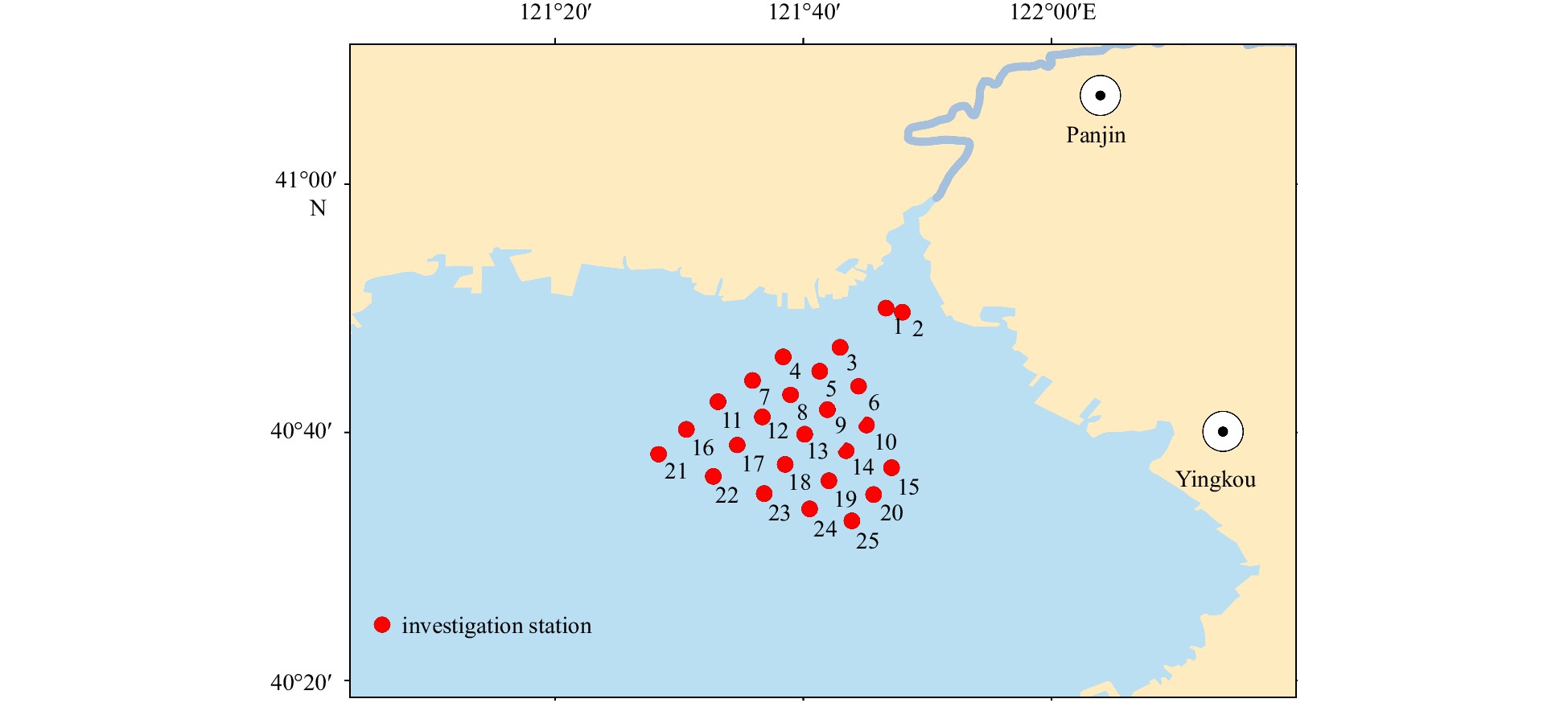
 下载:
下载:

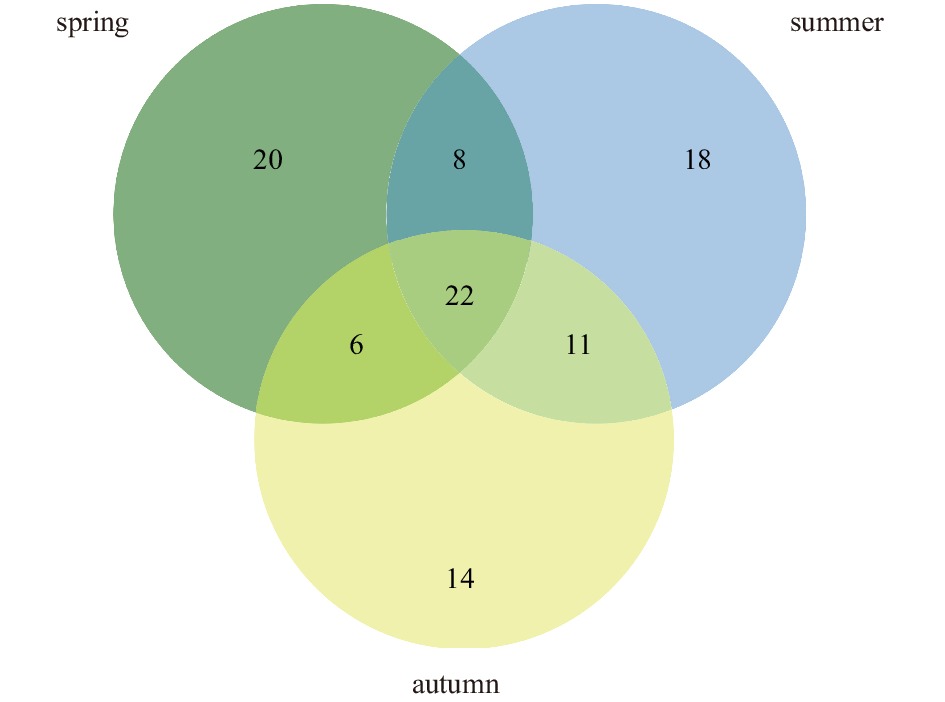
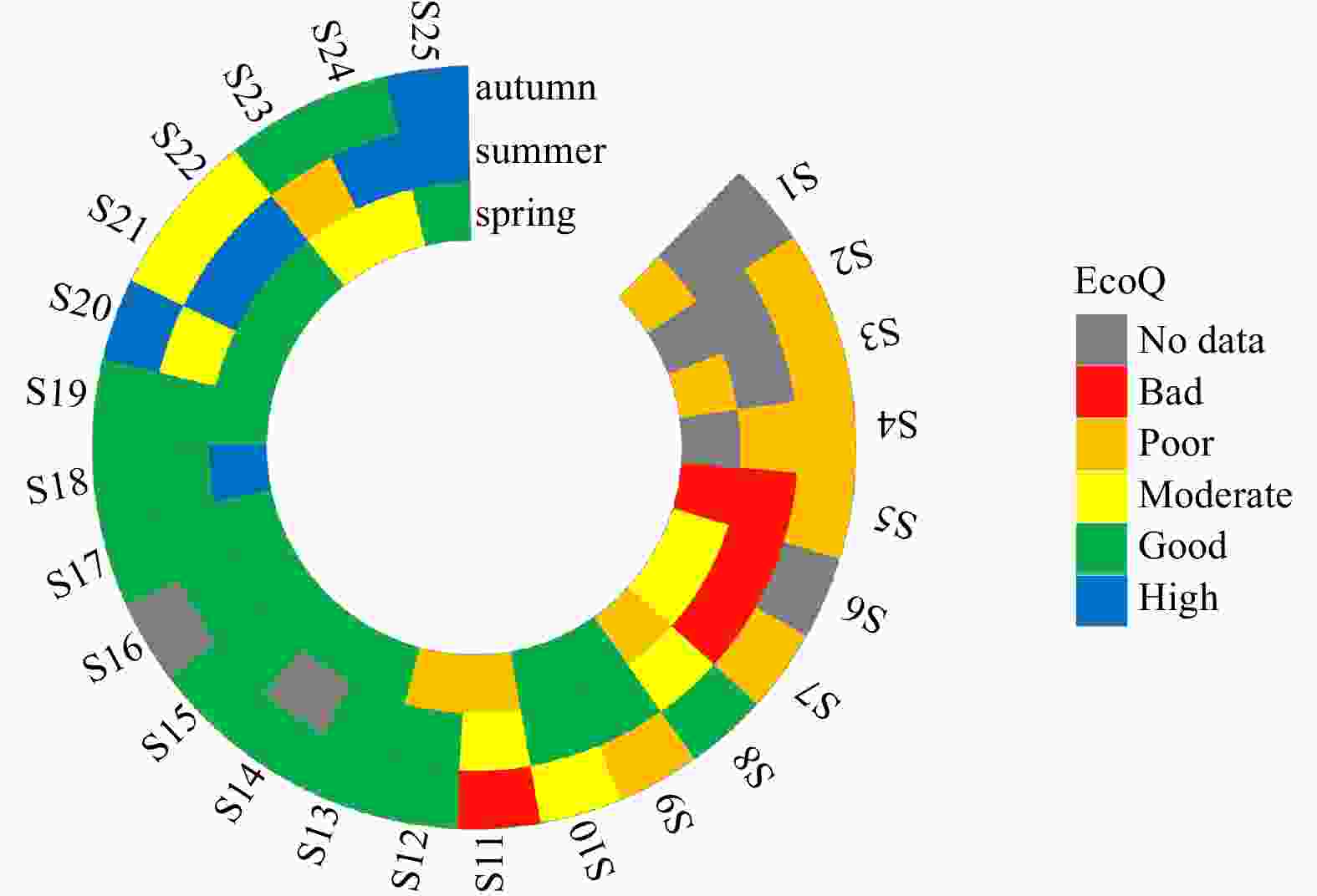

 , spring;
, spring;  , summer;
, summer;  , autumn).
, autumn).